What I’m learning about AI and the greenhouse
This month, I’ve been researching the topic of the “autonomous greenhouse” for stories for GrowerTalks and Inside Grower, interviewing Drs. Neil Mattson and A.J. Both, of Cornell and Rutgers, respectively. If you’ve been paying attention to this newsletter, you’ve read my occasional coverage of the Autonomous Greenhouse Challenge at Wageningen University in the Netherlands, where teams of very smart people develop computer programs (algorithms) that combine real-time data with historical data to determine the best combination of climate settings to achieve the end goal—which is maximum yield with the fewest inputs. There have been four of them thus far; Neil and A.J. were both on the 2022 winning team.
Anyway, it’s a complicated, multi-faceted topic that I am NOT an expert in … truth be told, I probably know enough to be dangerous. But here’s a few things I’ve taken away from my research:
- “Autonomous” in the big picture does not mean zero humans. In fact, the goal of the competition is to make growers’ jobs easier, more efficient and more profitable in the face of labor shortages and a changing climate. I think the technology will be a grower tool just like your environmental controls … in fact, the algorithm goes into your control computer and makes it “smarter.” And the more historical data it accumulates, the smarter it gets.
- You, the grower, will still be essential to tell the algorithm what the goal is. This week it might be energy savings. But next week, after a big order comes in, it might be maximum yield. I picture the algorithm as like a really good assistant grower who knows the crop but doesn’t know the big picture goals of the operation and needs of the customers.
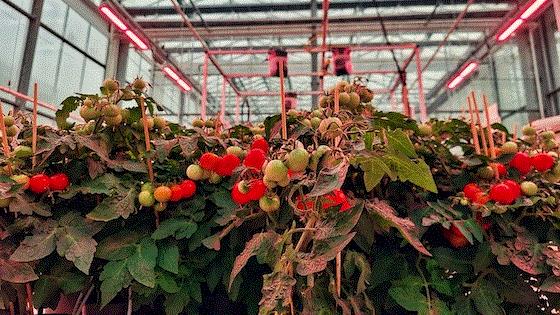
Dwarf tomatoes grown without human intervention during the most recent Autonomous Greenhouse Challenge. Photo WUR
- The reason so many scientists who are jumping on the autonomous bandwagon think it’s easy is because they don’t know biology. They think plants are widgets that all behave exactly the same in a factory setting. It’s a reason MIT’s so-called “food computer” project failed. You can’t put a seed in a box, close the door, fire up the computer and expect to find a beautiful head of lettuce 25 days later. You might … but you might find a pile of diseased mush. That’s why the Autonomous Greenhouse Challenge teams all include plant scientists—to keep the computer geeks grounded.
- Economics will determine just how autonomous we can get. Like anything you could invest in—lights, transplanters, conveyors—it has to provide some sort of payback. We will only automate to the point we can afford. The more people you try to eliminate, the more costly the system.
- For now, the technology is relegated to high-value monoculture crops like produce, medicinals/pharmaceuticals and perhaps young plants. Will a bedding plant grower be able to take advantage of an autonomous greenhouse algorithm? Only if the computer can balance the needs of petunias and geraniums in the same greenhouse.
Anyway, watch for my cover story in the October GrowerTalks, coming to your mailbox in a few weeks!
Got thoughts or experience or questions or answers about the autonomous greenhouse? Weigh in HERE.

Nurseryman to testify before Ag Committee on behalf of hort
The U.S. House Committee on Agriculture will be hosting a hearing titled “An Examination of the State of the Specialty Crop Industry” on September 16, and one of our own, Michael Frantz, will be there to testify on behalf of our industry.

Michael, a second-generation grower and nursery owner from Hickman, California, is president of Frantz Wholesale Nursery Company. He is also past chairman of the AmericanHort advocacy committee—the two reasons he was selected. At the hearing, he will “share real-world insight into the dynamics that impact greenhouse and nursery operations across the country,” said AmericanHort in the press release telling us the news. “Testimony will also highlight the importance of passing a Farm Bill and the innovation and resilience of growers as they work to provide essential products that feed, shade, and beautify communities nationwide.”
AmericanHort President & CEO Ken Fisher emphasized the significance of the testimony. “We are pleased to be invited to be part of this hearing as our members’ perspectives are critical to shaping smart policy. We’re proud to have Michael share his expertise and ensure the needs of this industry are part of this important national conversation.”
AmericanHort will be one of four organizations to give testimony at this hearing. The other participants include the International Fresh Produce Association (IFPA), the National Association of State Departments of Agriculture (NASDA) and an economist.

... and Jen Zurko will be there!
When Chairman GT Thompson calls the meeting to order at 10 a.m. EDT in room 1300 of the Longworth House Office Building, Editor Jennifer Zurko will be there! Jen was invited by AmericanHort to be part of the press corps covering the hearing, and she says she took approximately .1 nanoseconds to reply, “I don’t have to think about it—I’m in!” (She’s our staff political junkie). I know she’s excited to get an inside look at something we generally only see on the evening news or C-SPAN.
“I’ve been covering politics and industry advocacy for more than 10 years, so to get the opportunity to be a part of the press corps covering a congressional hearing along with journalists from major news sources is really exciting,” Jen said. “And the fact that a member of our industry gets a chance to speak directly to the House Ag Committee is so important in ensuring that the specialty crops segment is never an afterthought when legislation that directly affects us is being discussed. I know Michael will represent our industry well.”
A recording of the hearing will be made available afterwards on the House Agriculture Committee website and HERE at the AmericanHort website.

UConn Native Plants and Pollinators Conference November 13
The fifth biennial UConn Native Plants and Pollinators Conference will be held Thursday, November 13, at the UConn Student Union Ballroom in Storrs, Connecticut. It is the perfect place to catch up on the latest science-based research and information on supporting pollinator plants in managed landscapes.
The one-day program is designed for growers, landscape service providers, landscape architects and designers, town commissions, municipalities (and even home gardeners!).
Session topics include:
- Who are Connecticut’s Specialist Bees
- Soil Microbial Allies in Managed Systems
- Knockout Natives - Top performers and favorites of Phlox, Echinacea, wild hydrangea, Carex, Amsonia and Vernonia from Mt. Cuba Center’s research trials
- Seeing Nature - Draw gardening inspiration from images of plant and pollinator interactions captured beautifully and like you’ve never seen before
- Native Landscape Plants with Local Roots - Native shrub selections that were discovered in and originate from New England
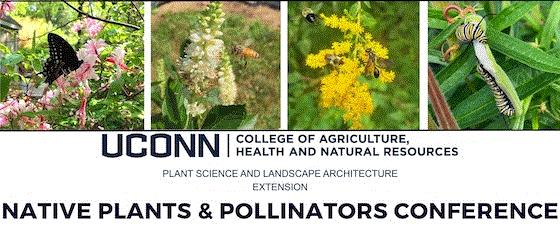
Early Registration (by October 15) is $70; after that it’s $80. Students with valid school ID pay just $25. Your registration includes continental breakfast, lunch, refreshments and pesticide recertification credits.

Download the newest Insecticide, Miticide & Fungicide Guide
I believe we’ve been producing GrowerTalks’ coveted INSECTICIDE, MITICIDE & FUNGICIDE GUIDE for nearly 20 years now with more than a dozen editions, including the one just released for 2026. Our newest guide (available in Spanish, too!) includes a fantastic range of articles, research findings, testimonials and the most comprehensive charts produced on an annual basis.
All of the updated tables and charts detailing greenhouse and nursery fungicides, insecticides and miticides are presented in an easy-to-follow way, organized by insect or disease and with complete mode of action (MOA) information.
The articles, written by experts from different disciplines cover specific diseases like Fusarium and insect pests such as Thrips parvispinus, as well as a profile of Tom Dodd Nurseries and research into the use of rice hulls and pre-emergence herbicides for weed control in container production.
Of course, throughout the guide, you’ll find countless other tips, tricks and new strategies to help your greenhouse or nursery take prevention and control to the next level.
As always, a hearty THANK YOU to our sponsor, BASF, for supporting this resource and offering research-based content and practical information in the guide.
Download the English edition HERE.
And the Spanish edition HERE.

Resource kit for those new to floral
Here’s a great idea that maybe we need for all segments of horticulture …
The Society of American Florists, recognizing that folks new to the floral industry might be overwhelmed by its diverse segments and complex global supply chain, has created a New Industry Entrants Resource Package—a toolkit that “provides essential knowledge and practical tools for a smooth entry into floral careers.”
The kit includes:
- Industry Basics: A 30-minute overview of the industry, including insights into the floral supply chain, sustainability practices and research on the health benefits of flowers.
- Challenges & Opportunities: Key data on consumer behavior, industry trends and forecasts to encourage strategic thinking.
- Working in the Industry: Realistic expectations about shop life, essential skills and the seasonal rhythms of floral work.
- Practical Tools & Networking: Access to webinars, professional development opportunities and SAF’s Floral Education Hub.

“These tools are designed for anyone entering or even expanding their role in the floral industry,” said Kate Delaney, SAF’s Director of Education. “By providing floral professionals with knowledge and resources early on in their careers, we’re helping individuals succeed, businesses retain talent and the industry as a whole grow stronger.”
Whether you’re a manager onboarding new hires, an independent designer looking for business insights, a student, or someone exploring a floral industry career, this toolkit provides a strong foundation for long-term success.
And what’s cool is that SAF has made the New Industry Entrants Resource Package available to members and non-members on their website. And it’s updated regularly with new tools and content.

Petal It Forward: Make one (or grow one), give one
I have long espoused the idea of giving away plants. As a grower, I used to enjoy gifting visitors with a potted mum or poinsettia or whatever it was we happened to be growing. Folks were blown away by the gesture! I don’t think there’s any better way to hook somebody on plants—especially a kid!
That’s why I appreciate SAF’s Petal It Forward program, an annual “goodwill initiative” in which floral pros surprise people in their community with two flowers or bouquets—one to keep and one to share. The official day for Petal It Forward is Wednesday, October 15.
And here’s the thing: You can do it any way that suits you, your business and your community. You don’t even have to be a florist—any retailer or grower can do it!
SAF offers these tips to make your event a success:
- Plan Ahead: Start by selecting a location and organizing your team. Past events have taken place outside of coffee shops, gyms, hospitals, senior centers and schools. Choose a high-traffic area where you’ll reach a lot of people in your community.
- Secure Product: Partner with your wholesaler or supplier to secure single stems or bouquets (assuming you didn’t grow it yourself).
- Promote Your Event: Develop a marketing and media outreach strategy to highlight your business and spread the word about the event. Make some video Shorts or Reels.
- Share Your Event on October 15: Capture photos of your preparations and your team giving out flowers. Share them on social media, tag SAF and use #PetalItForward.
HERE are five tips for doing a Petal It Forward event without blowing the budget.
Looking for inspiration? Check out THESE SUCCESS STORIES from past Petal It Forward participants.
Sign up to be an official participant HERE.

Funeral for a frond
Here’s a fun and clever idea passed along to me by fellow Editor Ellen Wells. It’s a story from CBS’s Sunday Morning called “The Pride and Perils of Plant Parenthood.” It talks about the one thing they never tell you when you become a plant parent: You might kill it.
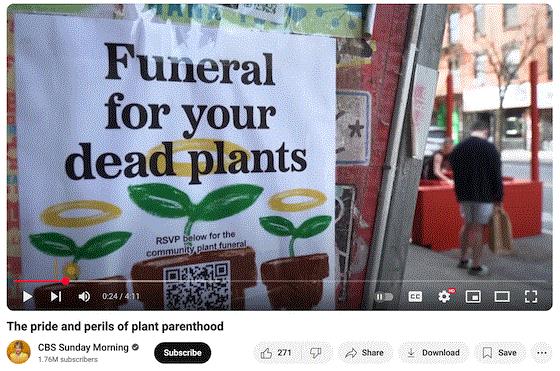
“What do you think was the fatal mistake for your plant?” asked the correspondent.
“That I bought it,” replied one mourner, who had brought the remains to an event in New York City called "Root in Peace, a Community Funeral for our Dead Plants." It was dreamed up by art director Doh Lee, who came back from a three-week vacation to find his sansevieria had expired.
The story features Dr. Melinda Knuth from NC State University.
Biobest’s portable mite and insect dispenser
With beneficial insects gaining in popularity in commercial greenhouses, growers are looking for better ways to put them out. Enter the Entomatic Handheld, Biobest’s new biocontrol dispensing device. It has been engineered for precision, speed and user comfort, they say, giving you an efficient new tool for targeted biological applications.
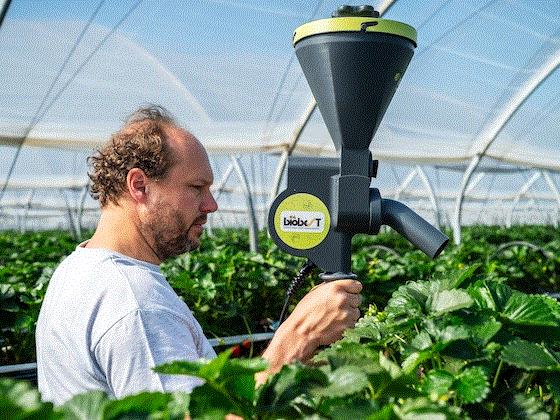 Developed in partnership with Hortiworld, which designs horticultural systems and machinery, the Entomatic Handheld has been designed for use in confined or irregular growing environments. Its compact and ergonomic design makes it ideal for linear crops such as strawberries, greenhouses with narrow paths or rolling benches, ornamental nurseries with variable layouts, and small-scale operations ranging from high-tech facilities to low-tech systems.
Developed in partnership with Hortiworld, which designs horticultural systems and machinery, the Entomatic Handheld has been designed for use in confined or irregular growing environments. Its compact and ergonomic design makes it ideal for linear crops such as strawberries, greenhouses with narrow paths or rolling benches, ornamental nurseries with variable layouts, and small-scale operations ranging from high-tech facilities to low-tech systems.
The unit is designed for focused, even distribution of beneficials such as Phytoseiulus persimilis, Amblyseius cucumeris, Orius laevigatus, and Franklinothrips. It can also dispense Biobest’s supplementary feed, Nutrimite, simultaneously. You can adjust dosing rotator and fan speeds to suit various crop and application needs. And for convenient refilling, the removable hopper lid also functions as a stand.
Learn more HERE.

Finally …
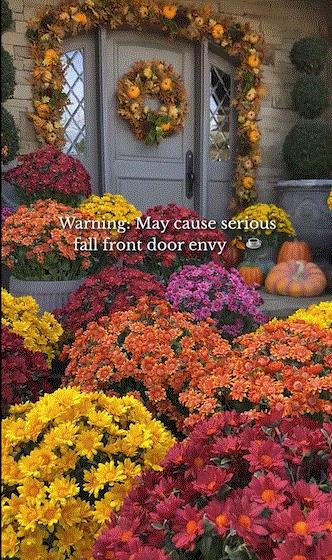
I spoke about artificial intelligence at the start. Well, one of you sent me a link to a Facebook page of a company called Wenary, which offers these frighteningly realistic artificial fall mums. They are on sale now for $15 (normally $30) for a set of five “bundles,” which are said to make the pot shown. The colors and flower forms are getting pretty good at mimicking the real thing, I’m sorry to say.
I suspect that convincingly realistic artificial plants and flowers is something we are going to be seeing more of, not less, so as growers and retailers (and journalists), we need to keep beating the drum about the benefits of the real McCoy—not the least of which is they consume CO2 and produce oxygen!
Those plastic plants? Well, how hard can it be to list their downsides, including being made from fossil fuels—something many people say they want to eliminate.
Remember what my friend Erika Santa from ForemostCo preaches:





Feel free to email me at beytes@growertalks.com if you have ideas, comments or questions.
See you next time!

Chris Beytes
Editor-in-Chief
GrowerTalks and Green Profit
This e-mail received by 29,752 loyal readers!
Thanks to my loyal sponsors, who help me reach the 29,752 readers of Acres Online in more than 60 countries. Want to be one of them (a sponsor, that is)? Give Kim Brown a shout and she will tell you about our many advertising opportunities.